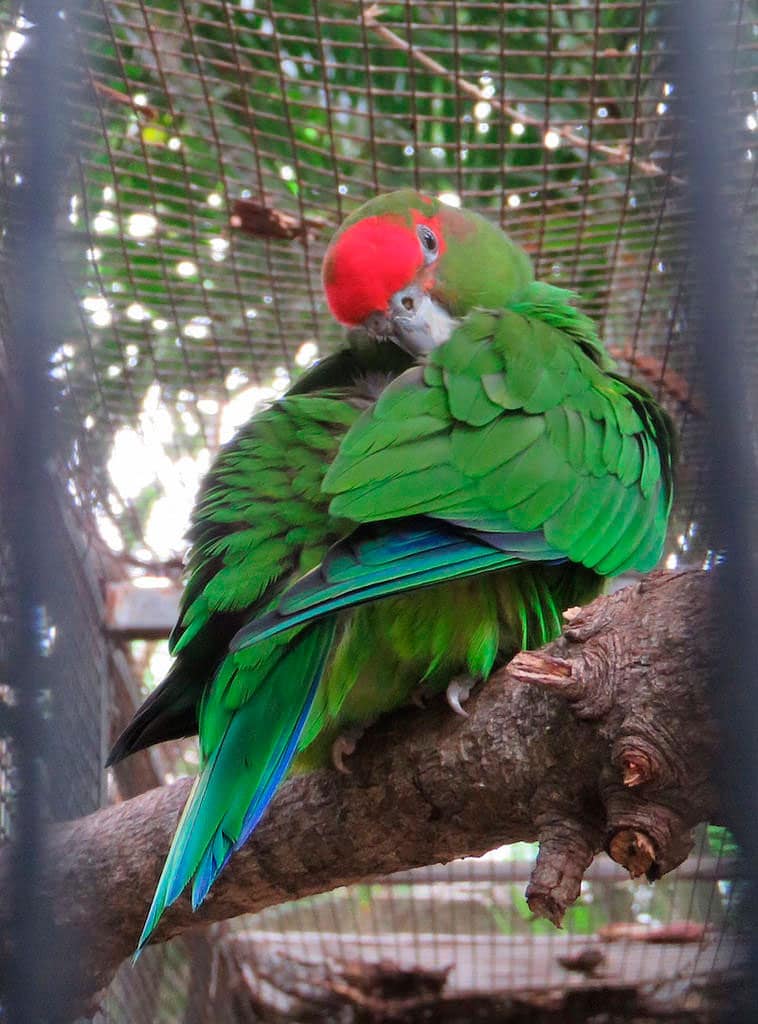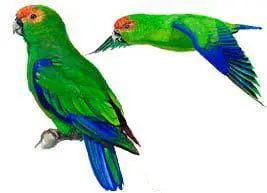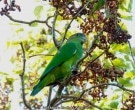Content |
|---|
Description:
22 cm.. length and a weight between 98-120 g..
The Pileated Parrot (Pionopsitta pileata) has the forecrown, lores, crown anterior upper cheeks to behind eyes, bright red; patch reddish brown in ear-coverts; the lower cheeks, sides and rear of the neck, green.
The upperparts, green. Primaries and greater coverts, alula and feathers bend of wing, violet blue; other coverts, green. Outerwebs of the primary and secondary, violet blue with blue-green edges. Under, the wings bluish green, coverts with some darker blue feathers. Underparts green with bluish tint in the chest and throat, and with a yellowish tint in the belly and undertail-coverts. Upper, the tail centrally green, laterally violet blue; undertail, bluish green.
Bill dark brown, becoming dark horn distally in both jaws; bare periophthalmic naked, pale grey, irises and legs, grayish brown.
The female has most of its head green but with a pretty pale blue in the forecrown.
Immature as female, but with grayish green or green spots and dark spots on the base bill; young male sometimes with red limited in forecrown with a patch orange behind.
- Sound of the Pileated Parrot.
Habitat:
They inhabit in forests, including humid tropical forests and forests dominated by araucarias, mainly in lowlands in the south of the mountain range, although penetrating the coastal mountains Brazil, at altitudes of 300 to 1.500 m; also in areas partially cleared. gregarious in groups of approximately 10 birds; apparently rare in greater numbers.
Reproduction:
They nest in the cavities of trees. probably reproduce mainly in the months of November to January. Clutch 3-4 eggs in captivity.
Food:
The fruits of Euterpe edulis They are among the favorite foods during the winter in eastern Paraguay; also recorded fruits Podocarpus and Solanum, and bark Eucalyptus; visit when ripe fruit orchards in Rio Grande do Sul.
Distribution and status:
Size of its range (breeding/resident ): 1.650.000 km2
The Pileated Parrot It is located in southeast Brazil, to the South of Bay, through the belt of the Atlantic forest in Espirito Santo, probably east of Minas Gerais, Brazil, Rio de Janeiro, São Paulo, Paraná and Santa Catarina, until Rio Grande do Sul, extending to the east Paraguay and northeast of Argentina in Missions and possibly in Currents (no recent records); also they have been reported east of Chaco in Argentina, where they can arrive as an irregular visitors.
Some seasonal movements occur Paraná, where birds leave the inland coastal plateau after breeding, and in Paraguay where it is in Amambay in October.
Nomad in the Intervales State Park of São Paulo. Its population is widespread but declining due to the extensive loss of forests by urban growth, agriculture and mining.
Described as uncommon to fairly common in Missions, Argentina. Apparently its population is still not at risk due to habitat loss, since birds are still quite numerous where fragments of forest remain. (for example, east of Paraguay) and travel between them on land without trees. More numerous are more extensive where the remains of forest, It is more common in eastern Paraguay and adjacent Paraná and São Paulo in Brazil.
Conservation:
• Current category of the Red List of the UICN: Least concern.
• Population trend: Stable.
Rationale for the Red List category
This species has a very large range and therefore it is not close to the thresholds for Vulnerable under the criterion of size range (Extension Occurrence <20,000 km2 combinada con un tamaño de rango decreciente o fluctuante, extensión / calidad de hábitat o tamaño de población y un pequeño número de lugares o fragmentación severa). La demographic trend appears to be stable and, therefore, the species does not approach the thresholds Vulnerable under the criteria of population trend (> 30% decline over ten years or three generations). The population size It has not been quantified, but it is not believed to be close to the thresholds for Vulnerable under the criterion of population size (<10.000 individuos maduros con un descenso continuo estimado> 10% in ten years or three generations or a population structure). For these reasons the species is evaluated as the least concern.
Justification of the population
The size of the world's population has not been quantified, but this species is described as “Rare” (Stotz et to the., 1996).
Justification of trend
They suspected that the population is stable in absence of evidence of any decline or threatens substantial.
"Pileated Parrot" in captivity:
Very rare in captivity.
Alternative names:
– Pileated Parrot, red-cappe parrot, Red-capped Parrot (English).
– Caïque mitré, Perroquet mitré (French).
– Scharlachkopfpapagei, Scharlachkopf-Papagei (German).
– Cuiú-cuiú, caturra, cuiú, cuiuiú, curica-cuiú, maitaca-de-cabeça-vermelha, periquito-rei, tui-maritaca (Portuguese).
– Catita cabeza roja, Catita decabeza roja, Lorito cabeza roja, Lorito de Cara Roja, Lorito Pileado (español).
– Catita cabeza roja, Catita decabeza roja (Argentina).
– Lorito cabeza roja (Paraguay).
scientific classification:

– Order: Psittaciformes
– Family: Psittacidae
– Genus: Pionopsitta
– Scientific name: Pionopsitta pileata
– Citation: (Scopoli, 1769)
– Protonimo: Psittacus pileatus
Images “Pileated Parrot”:
Videos "Pileated Parrot"
————————————————————————————————
“Pileated Parrot” (Pionopsitta pileata)
Sources:
– Avibase
– Parrots of the World – Forshaw Joseph M
– Parrots A Guide to the Parrots of the World – Tony Juniper & Mike Parr
– Birdlife
– Photos:
(1) – Pileated Parrot Loro Parque – Tenerife (Spain) by Florin Feneru – Flickr
(2) – Pileated Parrot Loro Parque – Tenerife (Spain) by Florin Feneru – Flickr
(3) – Pileated Parrot Loro Parque – Tenerife (Spain) by Florin Feneru – Flickr
(4) – Pionopsitta pileata by Taguató yetapa – Flickr
(5) – Red-capped parrot (Pionopsitta pileata) – “Appropriate” Campina Grande do Sul | The Birds of Brazil by Ben Tavener – Flickr
(6) – Catita Cabeza Roja by Argentavis – Birds of Argentina








it is possible to cross a “Cuiú-cuiú” (Pionopsitta pileata) with lovebirds ?